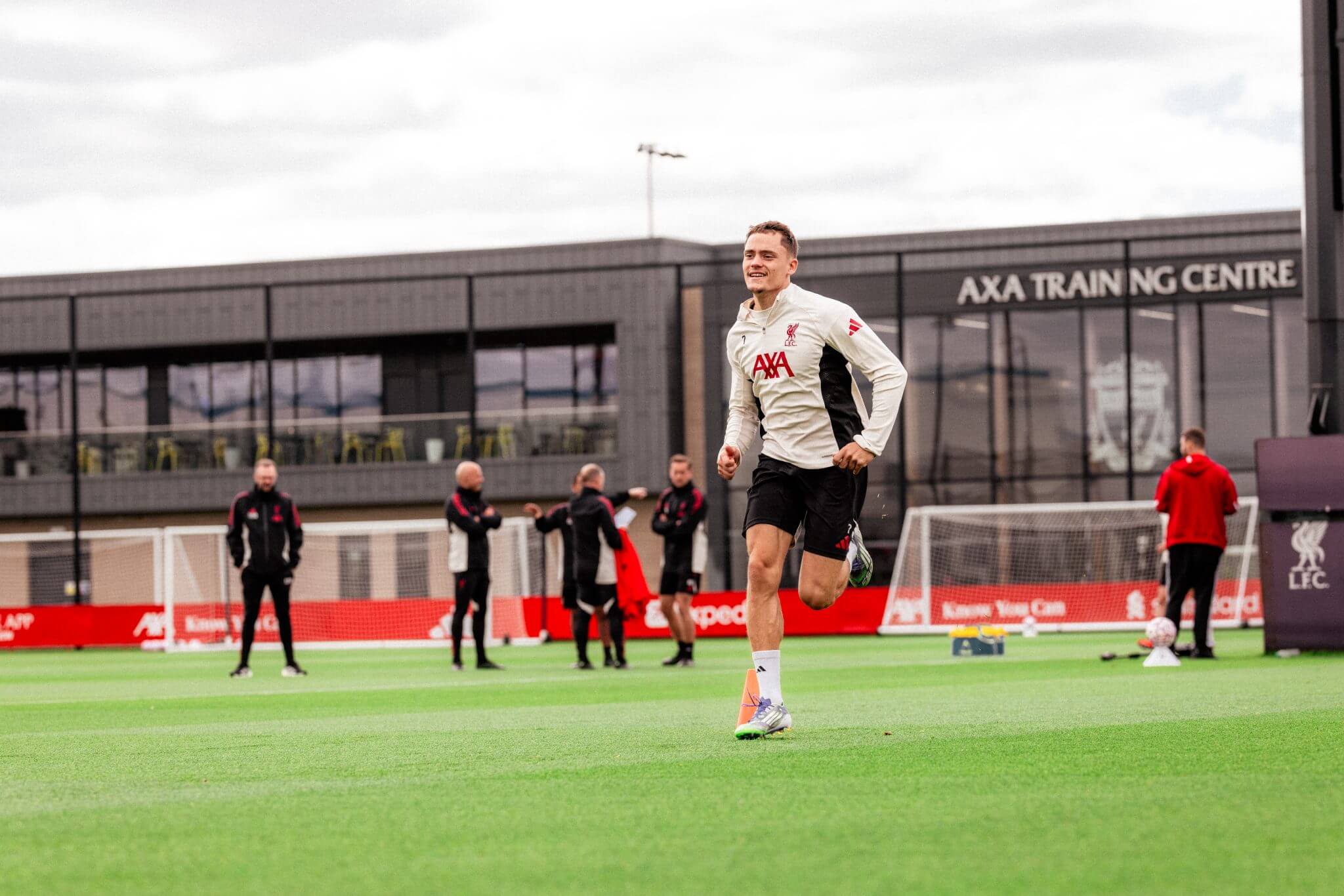There was a time, not so long ago, when Premier League clubs would sign players before they had even visited the training ground.
In 2002, when then Bolton Wanderers manager Sam Allardyce wanted to convince Jay-Jay Okocha to join from Paris Saint-Germain, he took him to the club’s impressively modern Reebok Stadium rather than their rundown practice facilities. “I didn’t do my research,” Okocha later told the BBC. “We didn’t even have changing rooms, we were changing in a (portable) cabin!”
Times have changed. Now, training grounds are becoming a yardstick by which you are measured — particularly in attracting new players, who are often provided with video tours of what awaits them, usually dressed-up with some suitably stirring music, by staff in the buying club’s recruitment team, before they join.
A key factor in Florian Wirtz’s decision to move to Liverpool from Bayer Leverkusen in the summer was a session at the Merseyside club’s Kirkby complex the day after playing a Champions League tie at Anfield last November. The superb setup made a lasting impression.

Florian Wirtz was impressed by Liverpool’s facilities when still a Leverkusen playerNikki Dyer – LFC/Liverpool FC via Getty Images
Similarly, Belgian goalkeeper Senne Lammens cited Manchester United’s base at Carrington — upgraded at a cost of £50million over the summer — as one of the reasons for joining them. “I saw a lot of it online already but when you come here and see it in real life, it’s something else,” he told United’s club media. “It’s the best of the best. New things everywhere.”
They are far from alone. A wide range of club recruitment figures consulted by The Athletic for this article — some of whom asked to remain anonymous, to protect their positions — say players are taking more interest than ever in the day-to-day facilities clubs have to offer, and are using these to help decide on where to move next.
That is particularly true of younger players who have fewer points of reference and more of their development and career still ahead of them. One recruitment figure compares youngsters visiting suitors’ training grounds to a “university open day”, with clubs vying with each other to showcase the best facilities.
It helps explain the unofficial training ground ‘arms race’ in England’s elite game, as rivals try to match or better each other to tempt the best talent to join them and persuade their current stars to stay.
It was in the late 1990s, as sports science began reshaping football, that a cultural shift began at English football’s training grounds.
Before then, many of these — even at leading clubs — were functional at best, and decrepit at worst. Top-tier sides such as Wimbledon and Crystal Palace trained on open-to-the-public parks pitches, where managers would conduct practice sessions among the dog-walkers and joggers. Even Liverpool’s old Melwood site backed onto suburban houses, with locals often resting ladders against the walls surrounding the training pitches to climb up, peer over and catch a glimpse of their heroes.

Liverpool fans look over the walls at the old Melwood training groundPaul Ellis/AFP via Getty Images
Manchester United’s decision to leave their historic headquarters, The Cliff, for a new purpose-built facility at Carrington marked the beginning of a trend towards more professional, and private, training grounds. That has continued ever since, with leading clubs driven by the growing need to evolve and stay ahead of the pack.
Visits to the United States, where performance centres across a range of sports are widely regarded as world-leading, have served as a source of inspiration. English clubs have drawn ideas from state-of-the-art facilities across the NFL and NBA, and even top-tier college American football programmes.
In April, the U.S. Soccer Federation will open a 200-acre National Training Center near Atlanta, which will become the national home of the sport. The facility is expected to be a game-changer and will provide the USMNT with enough time to prepare ahead of the World Cup it co-hosts next June and July.
United know the costs of falling behind. When Cristiano Ronaldo left the club in 2022 after a second spell, he claimed Carrington was “stuck in time” and that “nothing had changed” since he first departed, for Real Madrid, 13 years before.
Those criticisms appear to have been taken to heart. Carrington now features cutting-edge technology — from touchscreen training routines and underwater treadmills to ‘smart’ urinals, designed to monitor player hydration. A newly-built high-altitude room, equipped with bikes and rowing machines, is said to be one of the largest of its kind in elite sport, and the medical facilities feature a treatment room with nine beds overlooking the first-team training pitches, along with advanced MRI, CT and full-body scanners. There are also four recovery pools, plus upgraded sauna and steam room areas for optimal rehabilitation.

The first-team dressing room at Manchester United’s redeveloped CarringtonNigel Young/Foster + Partners
Away from the ‘work’, United also installed a barber’s studio, an F1 racing simulator (said to be particularly popular with midfielder Mason Mount) and a social space next to the fruit and coffee station just outside the dressing room.
The new Carrington is not without issues — as The Athletic reported on Tuesday, it has no space for the under-21 and under-18 teams, who are currently housed in temporary cabins, although discussions have started over constructing a bespoke academy building — but first-teamers are more than content.
Yet United are really only playing catch-up with their major rivals. Across town, Manchester City’s Etihad campus has long been regarded as a gold standard, with state-of-the-art academy facilities based on the same footprint as the first team.
That approach is mirrored by Liverpool, who left Melwood in 2020 for the £50million AXA Training Centre in the nearby Kirkby district of the city. There, they have three full-size pitches, a sports hall, a pool, hydrotherapy complex and specialist sports rehabilitation suites as well as dedicated office space for staff. The inclusion of a coffee shop is popular with players including Mohamed Salah, Dominik Szoboszlai, Virgil van Dijk and Curtis Jones, and was cited as one of the factors that brought the team together for their 2024-25 Premier League title-winning campaign.
As sporting director Richard Hughes observed at the IMG x RedBird Summit in September: “There’s nothing that these players will lack for.”

Liverpool’s state-of-the-art gym at KirkbyAndrew Powell/Liverpool FC via Getty Images
The battle to offer the most sophisticated and well-appointed training grounds is, in many ways, just as competitive as the squabble for the Premier League title itself.
United, Liverpool and City’s credentials are well established, with Arsenal and Chelsea close behind them, but Tottenham Hotspur, Aston Villa, and Leicester City — the latter spent £100million on their new training centre, which opened in 2021 — are also front-runners. Bournemouth recently opened a new £32m headquarters and both Nottingham Forest and Newcastle United have overhauled their facilities.
They are huge sums but also shrewd investments. Spending on infrastructure improvements such as training-ground upgrades is not included in the Premier League’s profit and sustainability rules (PSR) calculations, and clubs are seeing the value in going the extra mile on facilities which should protect the fitness (and value) of their greatest assets: the players.
It is also often far easier, and quicker, for them to redevelop or build entirely new training centres, which are often on brownfield or semi-rural sites, as opposed to stadiums that can be located in urban areas and which present a myriad of planning obstacles. For example, Palace were able to build a new £20million academy — widely hailed as one of the best facilities in the country — in 19 months. In contrast, it has been almost eight years since they announced a plan to redevelop just one stand of Selhurst Park, a project which has made little tangible headway.
In the second-tier Championship, too, there is a growing commitment to improve recovery areas for players, while the English Football Association have also recognised the need to keep pace with leading clubs by significantly upgrading what they offer at St George’s Park, the high-performance centre set in 330 acres of Staffordshire countryside, where the England men’s and women’s teams train.

St George’s Park, where England men’s and women’s teams trainGary Oakley – The FA/The FA via Getty Images
At the start of this year, the FA began a three-year staggered refurbishment. First, they began looking at the pitches, to improve wet-weather playability and also drew up plans to include new pitchside hubs.
Men’s head coach Thomas Tuchel requested a touchscreen TV for use in team meetings, although his women’s equivalent, Sarina Wiegman, prefers using a projector, as she conducts her meetings with the aid of a laser pointer. Both are now available in the site’s main briefing room. A new giant screen TV is also permanently in place on the main training pitch, which has been particularly well received by Wiegman, who previously used an externally-sourced TV during camps.
The most radical renovation, however, will see the inclusion of a new retreat aimed at enhancing the experience for players during their downtime. Included in the chill-out area will be padel courts (now a feature of many club training grounds), golf simulators and a cafe, as well as other personalised extras recommended through player feedback. “We will do all we can to make sure the areas are right for the players,” the venue’s general manager, Andy Savery, tells The Athletic.
Savery acknowledges there was a need for the FA to catch up. He estimates that around 75 per cent of Premier League clubs have upgraded their facilities since St George’s Park opened in 2012 but, through extensive research and deep analysis of 80 other venues, the FA is confident in the plans it has moving forward.
“The benchmark that the players are used to now has crept up,” Savery says. “So we’re trying to create more of a campus feel, and that means focusing heavily on the out-of-hours experience, too.”
“Flow” is a buzzword at training grounds and seen as a key concept when designing a new facility.
The aim is to ensure players and staff can transition seamlessly from one area to the next without unnecessary interruptions.
“It’s about trying to keep pushing players in a straight line towards the pitch,” Savery adds, admitting that St George’s Park hasn’t been able to master that yet as players occasionally switch between floors as they’re preparing for training, whereas the ideal route would start and finish on one level. Tuchel now asks for his players to be accommodated on the ground floor when they sleep at the on-site hotel to help this process.
Back at club level, Villa reshaped their Bodymoor Heath complex in 2019, taking inspiration from the setup at the TCO Performance Centre, non-matchday home to the NFL’s Minnesota Vikings.
In the main foyer, there is an honours board that greets visitors with a reminder of the club’s 1982 European Cup final success. Once through a private reception area, the setup is compact. The sports science and analysis team are located in rooms that lead into the gym. Rehabilitation work is done looking out onto the training pitches — a deliberate strategy to help injured players feel a part of the group — even when they’re not involved in any of the sessions. Then, as players walk into the boot room and out to the grass, a sign overlooks the entrance reading: “Winning starts here”.

Villa’s Bodymoor Heath training ground is one of the country’s bestNaomi Baker/Getty Images
Upstairs, and overlooking both the gym and the practice pitches, is what’s known as the “corridor of power”. It starts with meeting rooms, a mini auditorium, and further breakout rooms for individual sessions or video analysis. Scouts, analysts, and other support staff occupy the first set of offices, leading up to the room of Damian Vidagany, the director of football operations, and finally to manager Unai Emery’s office, which includes a private shower and bathroom.
There’s also a boardroom which is largely used for private meetings, or new signing pictures. A separate building includes a swimming pool with an adjustable floor and a cryotherapy chamber, all easily accessible from the gym. Staff appreciate how the layout brings all the key departments together and players feel both comfortable and motivated.
The benefits of the revamped facility are already being felt in recruitment. “Players like Harvey Elliott and Jadon Sancho (both summer arrivals) would have looked at the setup at Villa and recognised that despite leaving clubs with wonderful facilities (Liverpool and Manchester United respectively), they were remaining in an elite environment,” says a recruitment official at a Premier League club.
Amanda Cook, the founder of Design Tonic, a commercial interior design firm that has worked on projects with Leeds United, Liverpool, Arsenal and Forest, agrees that the flow of a facility is key. “We spend time in workshops working with key stakeholders on how a space can seamlessly transition from area to area,” she says. “Spaces need to feel connected and in the right order. We use clever flooring and graphic transitions which help direct without directing.”
The attention to detail is so advanced that even the layout of the canteen is crucial. When Design Tonic helped Leeds with changes at their Thorp Arch training centre, they introduced zoned seating, integrated open-plan ‘nutrition zones’ and smart acoustics to support communication. Bespoke flooring was used in the changing rooms, functional training zones were set up in the gym and communal areas were revamped to include comfortable seating and natural lighting.
Football staff were heavily involved with the layout, in a change from a decade or so ago. “The staff are key to a successful design,” adds Cook. “They are the ultimate users and understand the flow.”
Where to locate important staff members is also a crucial consideration in training-ground design. At both Manchester United and Liverpool, the player-care teams are positioned near the main entrance, ensuring that friendly, familiar faces are the first point of contact for players as they arrive. Villa’s player-care team, led by Phil Roscoe, have a vital role in helping new signings settle in. One key initiative is a digital welcome guide that includes introductory videos from each head of department.
Among the reasons players are so keen to know about the setup before joining a new club is the amount of time they will spend there. Training days are becoming longer, with more meetings around games and individual training plans taking on greater importance. It’s why clubs want their training ground to feel like a home from home, with improved eating options, sleeping pods and even hotel rooms attached to some venues.
At Tottenham’s Spurs Lodge, each player is assigned a bedroom, with no detail skipped. Lights automatically dim or brighten depending on the schedule of the day, bedding replicates what a person has at home and sofas are set up at angles to help their posture.
There is a risk that these hi-spec facilities may end up resembling five-star holiday resorts rather than places of work.
Leicester are a prime example. Their stunning Seagrave facility, which includes a luxury hotel, golf course and groundsman’s academy onsite, was designed by the club’s ambitious owners, who expected the team to be challenging for the Champions League every season after the 2016 Premier League title win, yet now it stands as a monument of how far they have fallen.
With Leicester back in the Championship after a second relegation in three seasons, some of the club’s former staff say Seagrave created a “more comfort than performance feel” as the “players were treated like kings”.

Leicester’s Seagrave training basePlumb Images
Former staff at Villa felt the same about Bodymoor Heath but Emery worked hard to change the culture. He pushed for performance-enhancing additions, like introducing floodlights so his players could train later in the evenings. Building work is also underway to add what will effectively be an on-site hotel to the complex in another of the manager’s recommendations. This new building will have 40 rooms, designed for players and staff to stay overnight when needed, particularly after late returns from away games, or ahead of early training and treatment sessions.
That could benefit players physically, although there may be psychological drawbacks if they are forced to spend more time at the training ground, especially when results are suffering.
Players usually spend around four to five hours a day at these facilities, and longer for their country when on international duty, but for all the efforts to create an enhanced social environment, most clubs accept their squads still prefer to rest and recuperate in their own space with friends and family around them.
Striking the right balance is key. Ultimately, if players can enjoy their time at the training ground while getting enough out of the working day to prepare for the next fixture, the belief among club staff is that they will then be ready to get results.
Over the past decade, a greater focus has been placed on mindset and mentality. It is why so many training grounds feature motivational quotes on the buildings’ walls as inspiration.
“Write the future” are the last words England players see before they head out onto the grass at St George’s Park, and on the staircase at Carrington, alongside some of the trophies of the past, there is an empty row of shelves reserved for any future Manchester United successes.
“It’s motivating for players to create their own history,” says a technical director with experience of helping design a training ground.
These touches are no guarantee of success, as Manchester United and Leicester know only too well. But in an increasingly competitive market, elite clubs know that any chance to gain an edge must be taken.
Credt: www.nytimes.com
Stay ahead with the latest updates!
Join The Podium Media on WhatsApp for real-time news alerts, breaking stories, and exclusive content delivered straight to your phone. Don’t miss a headline — subscribe now!
Chat with Us on WhatsApp







